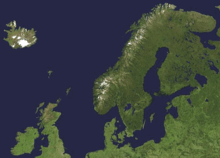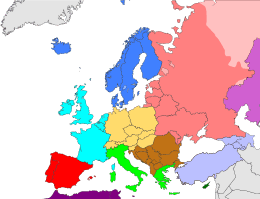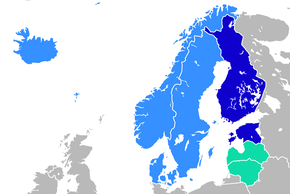Northern Europe
Northern Europe is the geographical region in Europe roughly north of the southern coast of the Baltic Sea, which is about 54°N. Narrower definitions may be based on other geographical factors such as climate and ecology. A broader definition would include the area north of the Alps.

Historically, when Europe was dominated by the Roman Empire, everything not near the Mediterranean region was termed Northern European, including southern Germany, all of the Low Countries, and Austria. This meaning is still used today in some contexts, for example, discussions of the Northern Renaissance.
Geography
Northern Europe might be defined roughly to include some or all of the following areas: British Isles, Fennoscandia, the peninsula of Jutland, the Baltic plain that lies to the east and the many islands that lie offshore from mainland Northern Europe and the main European continent. In some cases, Greenland is also included.
The area is partly mountainous, including the northern volcanic islands of Iceland and Jan Mayen, and the mountainous western seaboard, Scotland and Scandinavia, and also often includes part of the large plain east of the Baltic sea.
The entire region's climate is at least mildly affected by the Gulf Stream. From the west climates vary from maritime and maritime subarctic climates. In the north and central climates are generally subarctic or Arctic and to the east climates are mostly subarctic and temperate/continental.
Just as both climate and relief are variable across the region, so too is vegetation, with sparse tundra in the north and high mountains, boreal forest on the north-eastern and central regions temperate coniferous forests (formerly of which a majority was in the Scottish Highlands and south west Norway) and temperate broadleaf forests growing in the south, west and temperate east.
Classifications
Various definitions of Northern Europe often include the Nordic countries, and may also include some or all of the Baltic states, the British Isles, northern Germany, northern Belarus and northwest Russia.
CIA World Factbook

In the CIA World Factbook, the description of each country includes information about "Location" under the heading "Geography", where the country is classified into a region. The following countries are included in their classification "Northern Europe":[1]
as well as the dependent areas
In this classification, stagnant since the Cold War era, Estonia, Latvia and Lithuania are classified as being in Eastern Europe, while the UK and Ireland are included in Western Europe.
EuroVoc
.png)
EuroVoc is a multilingual thesaurus maintained by the Publications Office of the European Union, giving definitions of terms for official use. In the definition of "Northern Europe", the following countries are included:[2]
as well as the dependent area
In this classification, the UK and Ireland are included in Western Europe.
Demographics

Countries in Northern Europe generally have developed economies and some of the highest standards of living in the world. They often score highly on surveys measuring quality of life, such as the Human Development Index. Aside from the United Kingdom, they generally have a small population relative to their size, most of whom live in cities. Most peoples living in Northern Europe are traditionally Protestant Christians, although many are non-practicing. There are also growing numbers of non-religious people and people of other religions, especially Muslims, due to immigration. In the United Kingdom, there are also significant numbers of Indian religions such as Hindus and Sikhs, due to the large South Asian diaspora. The quality of education in much of Northern Europe is rated highly in international rankings, with Estonia and Finland topping the list among the OECD countries in Europe. The Hansa group in the European Union comprises most of the Northern European states.
See also
References
- CIA. "The World Factbook".
- Publications Office of the European Union. "EU Vocabularies 7206 Europe". EuroVoc.
External links
